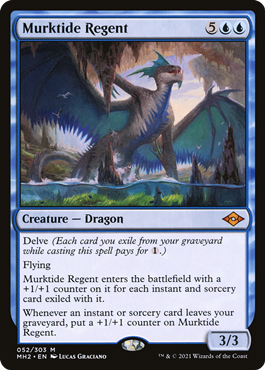Indomitable Creativity has shown up a few times, in a few different versions, during the last year or so of Modern’s history. The shells change, but the core game plan has stayed the same: control the board, then use Indomitable Creativity to generate a huge mana advantage.
Previous versions of Creativity chose Serra’s Emissary and Emrakul, the Aeons Torn as their payoffs. However, as cards like Teferi, Time Raveler and Solitude became more popular, the more vulnerable Emissary and Emrakul became. The last thing Creativity wants is to invest resources and a Creativity just to have the creature(s) they find get easily answered by popular cards.
The current version of Creativity has dropped all of the white cards, which means, no more Teferi, Time Raveler, Prismatic Ending and Serra’s Emissary — moving the deck from Four-Color to Temur.
Temur Creativity does have a Ziatora’s Proving Ground and a Blood Crypt so the deck can naturally cast the new payoff, Archon of Cruelty, though. Yet, while Archon is more vulnerable than either Serra’s Emissary or Emrakul, Archon will always get its money thanks to the triggered ability.
Unholy Heat may seem like a cause of concern given that it kills Archon for one mana, but I think Creativity is oddly okay with that exchange. When you consider you’re getting Unholy Heat out of an opponent’s hand, another opposing card, maybe an opposing creature, a three life drain and you get to draw a card, it looks like that Archon clocks in as a potential five for one. It doesn’t take many of those to win a game.
The other benefit to Archon over Emissary and Emrakul is you can actually cast Archon. Being able to cast Archon when you can’t have or can’t access Creativity, or when someone bounces your Archon, is crucial. Now that we understand why Creativity has made the move to Archon, let’s take a look at the rest of the deck.
Game Plan
Temur Creativity, as I mentioned earlier, is primarily a board control deck that aims to make it until turn four or five and then let Archon finish the game. We know the end point, but how do we get there?
Hard Evidence provides an excellent, early blocker, and also makes two targets for Indomitable Creativity down the line. Lightning Bolt, along with Wrenn and Six, gives Creativity plenty of early defense by cleaning up most of the small creatures in Modern. Spell Pierce provides some protection against combo decks, buys time against Burn and protects our Creativity.
Since Creativity has such a high degree of inevitability, the goal is just about surviving, as Archon is a better end game plan than most decks in Modern. Jace, the Mind Sculptor is a solid plan B against decks with a lot of removal because of its ability to take over the game when you have the ability to defend it.
You may think that turn for or five is slow for Modern, and for a long time it was. Not only is Modern fairer than it has been in a long time, which tends to mean that it is slower, but Explore and Prismari Command do a great job of helping you get ahead of the curve. It is worth noting that you can’t count on the treasure from Prismari Command to be an accelerant for Creativity if you lack another target, though.
Fable of the Mirror Breaker also fits perfectly in this deck since it makes a creature that also makes treasures, then it filters cards to look for Creativity. Transmogrify acts as additional copies of Indomitable Creativity, usually in small numbers, as it isn’t quite as good as Creativity.
Matchup Summary
It often takes quite a lot for decks in lower tiers to climb their way up to the level of “a competitive deck in Modern,” but Creativity has managed to span that gap. Creativity is a strong choice against a number of the good decks in the current metagame. Let’s take a look at some of the popular matchups.
Four-Color Yorion
Four-Color Yorion is a competitive match, but it favors Creativity. Teferi, Time Raveler and Solitude can certainly be annoying, though, especially if there is an Ephemerate paired with Solitude.
However, Creativity has the tools to keep up. That’s because Four-Color doesn’t interact well on the stack, so Creativity doesn’t need to sweat their spells getting countered often.
The main strength of Four-Color is that it can beat basically every deck on card advantage — but Creativity brings them back down to earth with Archon of Cruelty. If Creativity can set up a Creativity for two Archons, it is almost certainly game over for Four-Color unless they have Solitude plus Ephemerate.
And even then, they’re down two cards from Archon triggers, down up to two creatures and/or planeswalkers, possibly down a card from evoking Solitude, down six life and the Creativity player is up two cards and 24 life. That is an enormous resource swing.
Fable of the Mirror Breaker, Jace, the Mind Sculptor and Wrenn and Six all function as alternate win conditions that stress Four-Color’s answers.
Izzet Murktide
Izzet Murktide is a tough matchup for Creativity. As a combo deck on the slower side, Creativity is going to struggle against a lot of the tempo decks that can effectively get underneath them and leverage a couple pieces of interaction to finish the game.
Murktide Regent specifically poses an issue for Creativity players — first because they don’t have good answers for a creature that big, but also because they can’t block it with crab or dwarf tokens. Often, if the Murktide player can get a dragon into play with a counterspell still up, things look bad for Creativity (unless they can set up Creativity with Spell Pierce and hope that is good enough).
Things only tend to get worse after game one, when Murktide gets access to Blood Moon, which Creativity can struggle to play through due to the way it shuts off all of their ways to fight back against counterspells (also it shuts down Dwarven Mine). Creativity can be set up to be better in the counterspell fight with Flusterstorm, Veil of Summer and Mystical Dispute, but Murktide also gets better at winning that fight as well.
Generally, when both players are trying to fight on the stack over an expensive sorcery, the player casting the first spell is at a disadvantage. That naturally puts Creativity in a vulnerable position.
Hammer Time
Hammer is a fairly close matchup, and one that suffers from not having Serra’s Emissary. Creativity does have some early interaction with Spell Pierce, Lightning Bolt and Wrenn and Six, but they can do little about a creature that already has a Colossus Hammer on it.
Archon’s sacrifice ability doesn’t matter a ton, as Hammer Time usually has extra, low value creatures lying around that they don’t mind tossing out. Life does get easier for Creativity after sideboarding, though, once they get access to Force of Vigor and additional copies of Boseiju, Who Endures. Those can be brutal when combined with Wrenn and Six.
Burn
Burn is a negative matchup for Creativity. Lacking any early pressure at all, Burn gets enough time to set up, often allowing it to beat an Archon trigger. However, two Archon triggers is likely too much for Burn to overcome.
This means that Creativity is looking to resolve a Creativity for X=2 if possible, to guarantee two triggers. It is worth noting that Skullcrack can be a blowout if you go for the two Archon line. But if it works, you give the Burn player one fewer draw step because you don’t need to wait to attack.
The matchup is simple — it is a race to see if Creativity can get two Archon triggers before they die. If they can, they likely win.
Death’s Shadow
Following the previous premise of tempo decks being strong against Creativity, you’d think that Shadow has an excellent matchup against Creativity. Yet in practice, it is much worse than Murktide.
The reason? Creativity decks can block Death’s Shadow for extended periods of time, giving them time to set up Archon. Unlike Murktide, Shadow decks also often need to go to a low life total to apply pressure, which opens them up to dying to Archon triggers, extra Lightning Bolts, or even getting attacked by Dwarf tokens.
Veil of Summer is a big problem for Shadow decks, which means that Creativity has a high impact sideboard card in the matchup. It’s also worth noting that Shadow decks aren’t going to have Blood Moon, which is good news for the Creativity player.
I advise playing this matchup as the control deck — staying alive and piecing together kills with Archon triggers and Lightning Bolts. It’ll work a surprising amount of the time.
Shadow also loads up on Spell Pierce and Flusterstorm after sideboarding to fight Indomitable Creativity, which means casting Archon naturally will happen frequently.
Living End
Creativity decks have almost no recourse to the opponent casting Living End. Game one is just find the Spell Pierce, and in game two, Creativity gets access to Flusterstorm. But that only goes so far, given that Creativity can’t apply pressure to back up the Flusterstorm.
Living End is just a faster and better version of Indomitable Creativity. All you can really hope to do is respond to Living End by using Prismari Command to dump Archons into the graveyard — but that only works by turn three on the play, and it requires a lot of things to go right.
If Living End is popular, I may recommend finding room for Leyline of the Void in the sideboard and trying to mulligan to it.
Rhinos
Rhinos is a closer matchup than Living End, but also not a great matchup for Creativity. Going back to the tempo deck statement, Rhinos don’t fly — but they do have Trample and they do come in pairs. That means that blocking doesn’t work well. Plus, even if you remove one, there is another to take its place.
Creativity is usually fairly safe in game one, as Rhinos only have Force of Negation for interaction. But if they do have Force, they’re free to use all of their mana putting pressure into play, which can spell disaster for Creativity.
Things only tend to get worse after sideboarding, when Rhinos get access to a pile of Blood Moons to go along with their Rhinos and counterspells. Playing this matchup is about having Boseiju available to beat Blood Moon, and trying to resolve a Creativity for two Archons.
Rhinos can fight through one Archon fairly easily by bouncing it with Brazen Borrower, however, or simply just going around it with a bunch of rhinos.
End step
Hopefully, if you’re looking for a deck to play in an upcoming RCQ, this helps put Creativity on your radar. Creativity certainly has the chops to win a tournament, much like any competitive deck in Modern.
The deck has matchups it likes and matchups it wants to avoid. If your local metagame has a lot of Four-Color, Hammer and Shadow, I’d say take Creativity for a spin.
As always I’ll see everyone here next week! In the meantime, you can always find me on Twitter at @RappaciousOne for questions, comments and feedback.

Michael Rapp is a Modern specialist who favors Thoughtseize decks. Magic sates his desire for competition and constant improvement.

















